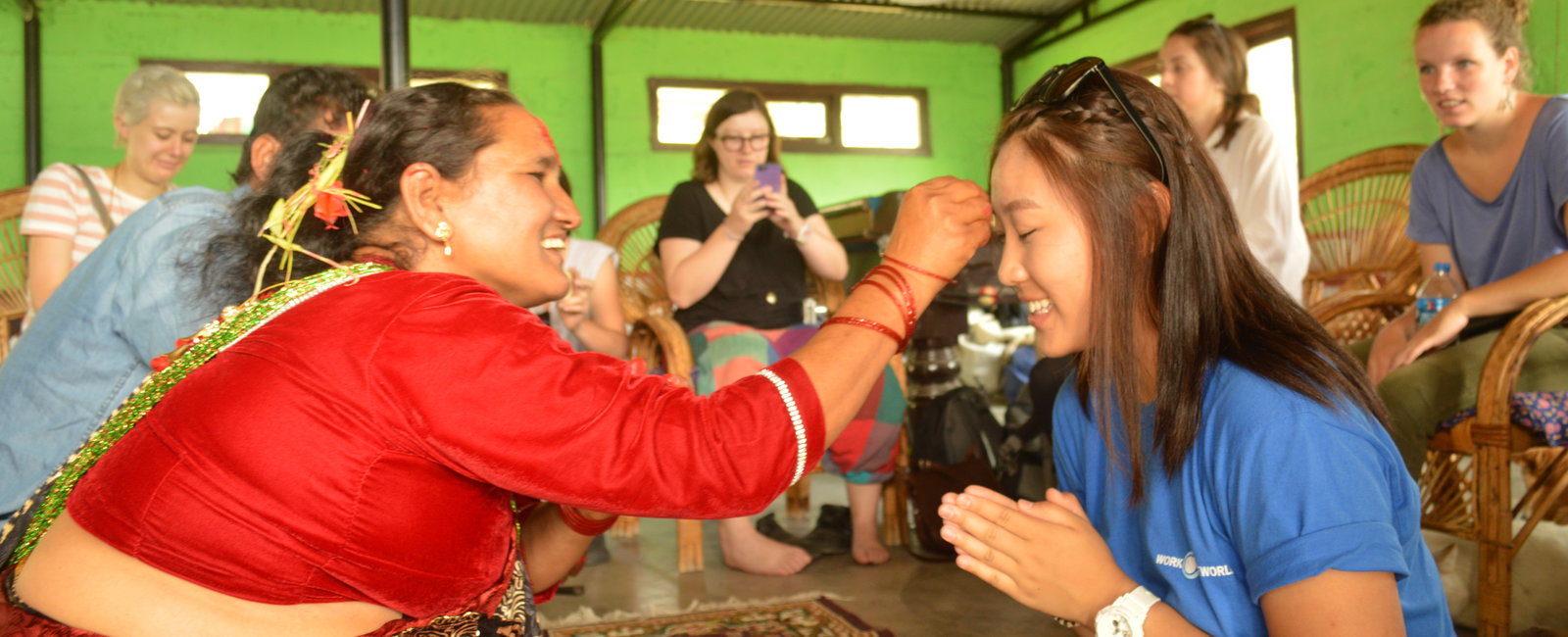Sri Lanka condenses masses of amazing travel opportunities into one tiny country. Miles of unspoilt coastline with world-class surf, ancient civilisations, UNESCO heritage sites, elephants, whales and one of the biggest festivals in South East Asia.
The climate is tropical, with distinct wet and dry seasons. There are two monsoons though, which can be confusing, and depending on where you are in the country you may find your time very wet or completely dry! The good thing is that there is always a "dry season" spot to go to, but be prepared - feedback from our stundets suggests that wet and dry seasons shouldn't be wholly relied upon and it is not uncommon for the heavens to open for half an hour. Sometimes that can be quite refreshing though!
Whatever the weather, there is masses to do in Sri Lanka.
Please note that there have been some concerns over the welfare of the elephants at Pinnewala. Students are advised to give them space and not to touch them (no matter how tempting it is!).
January
Adams peak: Legend has it that this is the first place Adam touched when he set foot on earth, and that the large footprint at the top is the sacred step of Buddha on his way to paradise. Each year there is a mass pilgrimage to the top. January is very busy with pilgrims and travellers hiking to the top to watch the sunrise over the hill country.
Galle: UNESCO World Heritage protected Galle Fort is an 18th-century Dutch walled town with chic shops, grand colonial houses and beautiful beaches. It is a beautiful place to explore and with guidebooks a plenty are referring to it as an "undiscovered gem". With so many on the case though it is fast getting discovered, so get there before it becomes mainstream!
Yala National Park: Dry season channels elephants to the waters edge, and this is the best time of year to spot them with babies.
Whale watching: Dondra Point in the South offers a 95% chances of spotting sperm whales, and you may even spot a blue whale - their migration path is just off of the coast.
Dolphin watching: Trips from Kalpitiya suggest that passengers can witness 1000-1500 dolphins!
Festivals: Duruthu Perahera, held on poya day (full moon), is a huge Columbo-based festival that is nearly as big as Esala Perahera. It has a huge colourful street procession that is worth watching.
February
Adams peak: February is also a busy season and it's easy to see why - the weather is perfect for the trek and you should get a beautiful sunrise if you can get out of bed to trek to the top before dawn. You may even be able to see as far as Columbo.
Galle: This is the peak time for Galle and is likely to be very busy. Hard to resist those glorious blue skies, wonderful views, windy streets and markets though...
Yala National Park: There are still lots of elephants hanging around the waters edge, introducing their young to the fun and games of water! You are also likely to see sloth bears, crocodiles and monkeys in the park.
Panadura Wildlife Research Centre: This is peak nesting time for the turtles and you can watch the females lumbering up the beach to lay their eggs.
Sinharaja Rainforest: This is the best time to visit Sri Lanka's only remaining rainforest - a protected zone. You will see thousands of birds and butterflies, as well as reptiles, cats and pangolins.
Dolphin watching: Boats from Kalpitiya can see up to 1500 dolphins on each trip!
March
Galle: Still a good time to explore the ancient fort city.
Adams peak: pilgrimage season is still on, but it's not as busy. If the weather is good you may still get that perfect picture shot of the sunrise above the clouds along the coast.
Yala National Park: This is still a good time to go to Yala - the elephants are still grouping at the water and sloth bears, crocodiles and monkeys are common.
Panadura Wildlife Research Centre: The turtles are still nesting and you can watch at night as they leave the water and travel up the beach to lay their eggs.
Sinharaja Rainforest: Thousands of birds and butterflies, as well as reptiles, cats and pangolins populate this last remaining Sri Lankan rainforest.
Dolphin watching: You can still take trips around Kalpitiya to see the large groups of dolphins.
April
Adams peak: Pilgrimage season is still on, but it's not as busy.
Yala National Park: The season is starting to change, but you can still see plenty of wildlife in the National Park.
Panadura Wildlife Research Centre: The turtles are still travelling to the beaches to lay their eggs.
Sinharaja Rainforest: The weather is still good for birds and butterflies.
Whale watching: This is another key month for whales off of Dondra in the South. Sperm whales and blue's are regularly spotted.
Festivals: Celebrate new year Sri Lankan style! In mid April, Buddhists and Hindus perform a series of traditions for Aurudu, including lighting the hearth to heat coconut milk and settling down to the first meal of the new year. Each tradition is performed at set times to ensure good fortune for the year ahead. People return home (public transport can be packed) and businesses close down, so if you are planning trips then be prepared for high prices and busy journeys. It is probably more fun to stay in Kandy and enjoy that family atmosphere. The Aurudu celebrations usually mean special food is shared, firecrackers sound and gifts are given.
Surfing: Surfer dudes (and those who enjoy watching) can enjoy some of Sri Lanka's famed surf.
May
Adams peak: The Vesak festival half way through the month closes pilgrimage season. After this it is largely deserted and clouds regularly obscure the view.
Yala National Park: Still a good time to visit the National Park as until the rains properly start the focus is the watering holes - that means it is easy to find the elephants, sloth bears, crocodiles and monkeys.
Panadura Wildlife Research Centre: Turtles a plenty on the beaches.
Festivals: Vesak Poya is a two day holiday to commemorate the birth, death and enlightenment of Buddha. Puppet shows and open air theatre performances take place and paper lanterns and oil lamps are lit across the whole country.
Whale watching: Trincomalee is the place to head at this time of year. Trips are not so easy to come by as in the south, but it is possible to arrange trips to see blue whales and sperm whales.
Surfing: Surfs up! Ocean swells are consistent 4-7 feet and wind conditions are ideal.
June
Panadura Wildlife Research Centre: You can still watch turtles lay eggs on the beach.
Whale watching: Trincomalee offers trips to see blue whales and sperm whales from the North.
Surfing: With the winds offshore, swells consistent and rain at a minimum, this is the perfect time to take your board to the sea.
July
Kandy Esala Perahera: the 10-day festival honouring the sacred tooth relic of the Buddha, and also the time for the Kataragama festival in the South.
Panadura Wildlife Research Centre: This is peak nesting time for the turtles and you can watch the females lumbering up the beach to lay their eggs.
Whale watching: You still have a chance of spotting sperm whales and blue whales from Trincomalee.
Surfing: There are lots of surf spots around the island for beginners as well as advanced.
August
Whale watching: The weather is poor in the South, but the North is good! Head to Trincomalee for whale watching tours.
Minneriya National Park: The Minneriya Reservoir (also known as the Minneriya Tank) is a huge, ancient, man made reservoir covering 8,900 Hectares. It never runs dry and so the areaaround it is lush and green, providing the perfect watering hole for elephants during the dry season. Several herds of wild Asian elephants gather together, some travelling from many miles away. It leads to a unique phenomena not seen anywhere else in the world, where as many as 300 play and interact.
Surfing: With the winds offshore, swells consistent and rain at a minimum, this is the perfect time to take your board to the sea.
September
Surfing: This is a great time to learn to surf, and perhaps one of the best places to do it!
October
Bundala Nature Reserve: 4 species of marine turtles lay their eggs.
Festivals: Deepavali, the Hindu festival of lights takes place and thousands of oil lamps are lit to celebrate the triumph of good over evil.
November
Yala National Park: Yala closes during mating season, reopening in November. With one of the largest concentrations of leopards, this park offers one of your best bets for spotting the elusive cat with her cubs.
Dolphin watching: Trips from Kalpitiya suggest that trips can witness 1000-1500 Dolphins!
December
Adams peak: The beginning of the pilgrimage season is marked on poya day (full moon). Join hundreds of pilgrims and travellers as they trek to the top.
Yala National Park: You may still spot some cubs following mating season. Leopard cubs... what could be cuter!
Whales: Whale watching from Dondra in the South is perfect. There is 95% chances of spotting Sperm Whales and great chances of spotting Blue Whales as their migration path is just off Dondra Point.
Dolphin watching: Dolphins are still frolicking off the shores in Kalpitaya.




